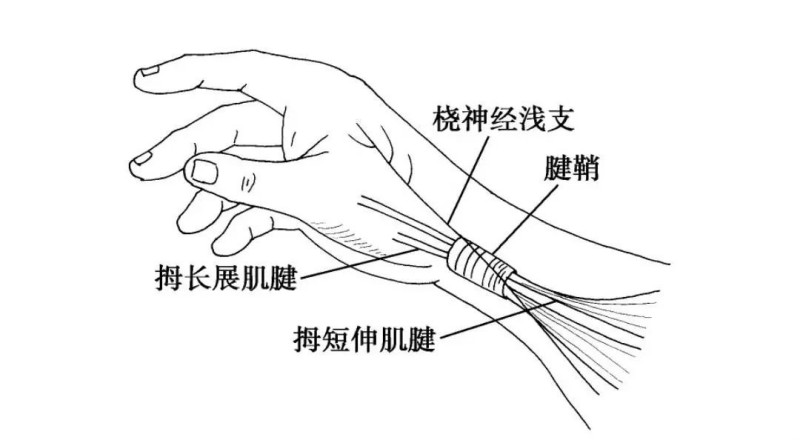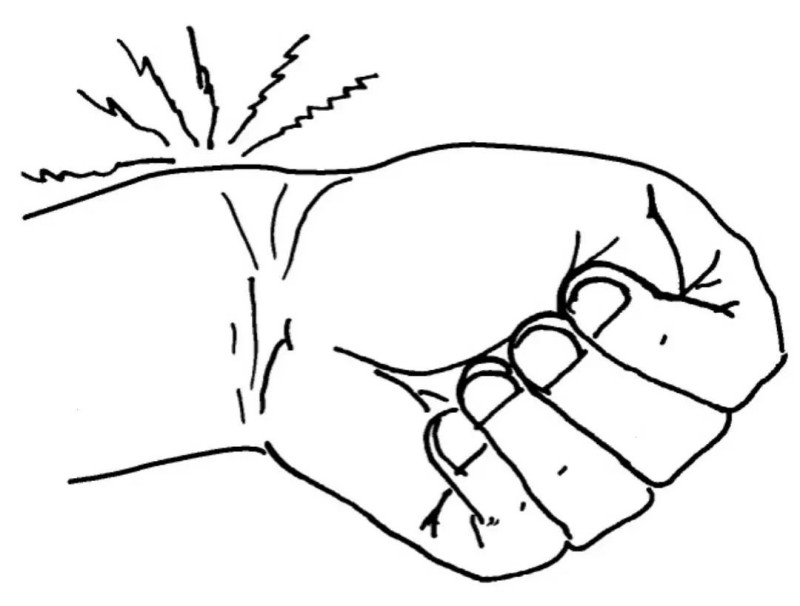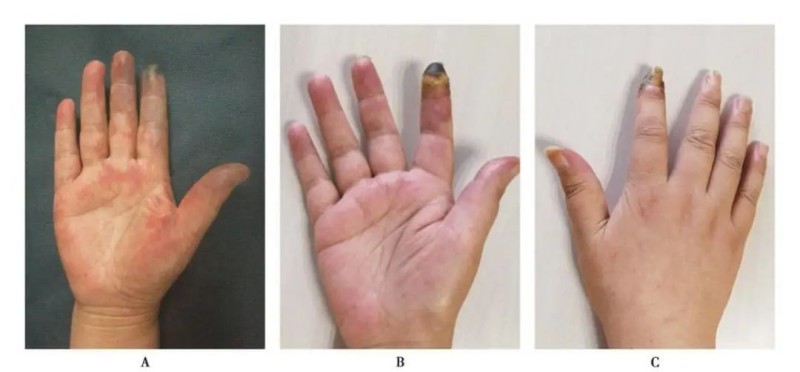Styloid stenosis tenosynovitis jẹ iredodo aseptic ti o fa nipasẹ irora ati wiwu ti abductor policis longus ati awọn tendoni extensor pollicis brevis ni apofẹlẹfẹlẹ carpal dorsal ni ilana radial styloid. Awọn aami aisan buru si pẹlu itẹsiwaju atanpako ati iyapa calimor. Arun naa ni akọkọ royin nipasẹ oniṣẹ abẹ Switzerland de Quervain ni ọdun 1895, nitorinaa radial styloid stenosis tenosynovitis ni a tun mọ ni arun de Quervain.
Arun naa jẹ wọpọ julọ ni awọn eniyan ti o ni ọwọ nigbagbogbo ati awọn iṣẹ ika ọwọ, ati pe a tun mọ ni “ọwọ iya” ati “ika ere”. Pẹlu idagbasoke Intanẹẹti, nọmba awọn eniyan ti o ni arun na n pọ si ati ọdọ. Nitorinaa bawo ni a ṣe le ṣe iwadii ati tọju arun yii? Awọn atẹle yoo fun ọ ni ifihan kukuru lati awọn aaye mẹta: eto anatomical, iwadii ile-iwosan ati awọn ọna itọju!
I.Anatomi
Ilana styloid ti rediosi ni dín, sulcus aijinile ti o bo nipasẹ iṣan carpal ẹhin ti o ṣe apofẹlẹfẹlẹ fibrous ti egungun. Awọn abductor pollicis longus tendoni ati extensor pollicis brevis tendoni kọja nipasẹ apofẹlẹfẹlẹ yii ati ki o pọ ni igun kan ki o si fopin si ni ipilẹ egungun metacarpal akọkọ ati ipilẹ ti phalanx isunmọ ti atanpako, lẹsẹsẹ (Figure 1). Nigbati awọn ifaworanhan tendoni, agbara ija nla wa, paapaa nigbati iyapa ulnar ọrun-ọwọ tabi gbigbe atanpako, igun agbo pọ, jijẹ ija laarin tendoni ati odi apofẹlẹfẹlẹ. Lẹhin igbaduro igba pipẹ ti o leralera, synovium n ṣe afihan awọn iyipada iredodo gẹgẹbi edema ati hyperplasia, ti o nfa didan, ifaramọ tabi dín ti tendoni ati odi apofẹlẹfẹlẹ, ti o mu ki awọn ifarahan ile-iwosan ti stenosis tenosynovitis.
Fig.1 Anatomical aworan atọka ti awọn styloid ilana ti awọn rediosi
II.Clinical okunfa
1.The egbogi itan jẹ diẹ wọpọ ni arin-ori, Afowoyi awọn oniṣẹ, ati diẹ wọpọ ni obirin; Ibẹrẹ lọra, ṣugbọn awọn aami aisan le waye lojiji.
2.Signs: irora ti agbegbe ni ilana styloid ti radius, eyi ti o le tan si ọwọ ati iwaju, ailera atanpako, ipari atanpako ti o ni opin, imudara awọn aami aisan nigbati ilọsiwaju atanpako ati iyapa ulnar ọwọ; Awọn nodules palpable le jẹ palpable ni ilana styloid ti radius, ti o jọra giga ti egungun, pẹlu tutu ti o samisi.
3.Idanwo Finkelstein (ie, idanwo iyapa ulnar ikunku) jẹ rere (gẹgẹbi a ṣe han ni Nọmba 2), atanpako naa ni rọ ati ti o waye ni ọpẹ, ọrun-ọwọ ti yapa, ati irora ni ilana radius styloid ti buru si.
Ayẹwo 4.Auxiliary: X-ray tabi ayẹwo olutirasandi awọ le ṣee ṣe ti o ba jẹ dandan lati jẹrisi boya aiṣedeede egungun tabi synovitis wa. Awọn Itọsọna fun Itọju Ẹya-ọpọlọpọ ti Styloid Stenosis Tenosynovitis ti Radius Akiyesi pe awọn idanwo ti ara miiran ni a nilo lati ṣe iyatọ laarin osteoarthritis, awọn rudurudu ti eka ti iṣan ti iṣan radial, ati forearm cruciate syndrome ni akoko ayẹwo.
III.Itọju
Itọju Konsafetifu Itọju ailera aibikita: Ni ipele ibẹrẹ, awọn alaisan le lo àmúró imuduro itagbangba lati ṣe aibikita ẹsẹ ti o kan lati dinku awọn iṣẹ agbegbe ati yọkuro ikọlu ti tendoni ninu apofẹlẹfẹlẹ tendoni lati ṣaṣeyọri ibi-afẹde itọju. Sibẹsibẹ, aibikita le ma rii daju pe ẹsẹ ti o kan wa ni aaye, ati pe aibikita pẹ le ja si lile išipopada igba pipẹ. Botilẹjẹpe awọn itọju aibikita-iranlọwọ awọn itọju miiran ni a lo ni ilodisi ni adaṣe ile-iwosan, ipa ti itọju jẹ ariyanjiyan.
Itọju ailera ti agbegbe: Gẹgẹbi itọju ailera Konsafetifu ti o fẹ fun itọju iwosan, itọju ailera ti agbegbe n tọka si abẹrẹ intrathecal ni aaye irora agbegbe lati ṣe aṣeyọri idi ti egboogi-iredodo agbegbe. Itọju ailera le fa awọn oogun sinu agbegbe irora, apo apofẹlẹfẹlẹ apapọ, ẹhin ara ati awọn ẹya miiran, eyi ti o le dinku wiwu ati fifun irora ati fifun awọn spasms ni igba diẹ, ati ki o ṣe ipa ti o tobi julọ ni itọju awọn ọgbẹ agbegbe. Itọju ailera jẹ nipataki ti triamcinolone acetonide ati lidocaine hydrochloride. Sodium hyaluronate injections tun le ṣee lo. Bibẹẹkọ, awọn homonu le ni awọn ilolu bii irora abẹrẹ lẹhin-abẹrẹ, pigmentation awọ ara agbegbe, atrophy àsopọ abẹ awọ-ara agbegbe, ipalara nafu ara radial symptomatic, ati glukosi ẹjẹ ti o ga. Awọn contraindications akọkọ jẹ aleji homonu, aboyun ati awọn alaisan lactating. Sodium hyaluronate le jẹ ailewu ati pe o le ṣe idiwọ ogbe ti awọn adhesions ni ayika tendoni ati igbelaruge iwosan tendoni. Ipa ile-iwosan ti itọju occlusive jẹ kedere, ṣugbọn awọn ijabọ ile-iwosan wa ti negirosisi ika ti o fa nipasẹ abẹrẹ agbegbe ti ko tọ (Nọmba 3).
Fig.3 Apakan occlusion nyorisi negirosisi ti awọn ika ika ti awọn ika itọka: A. Awọ ti ọwọ jẹ patchy, ati B, C. Aarin apa ti ika itọka ti o jina jina, ati awọn ika ika jẹ negirosisi.
Awọn iṣọra fun itọju occlusive ni itọju ti radius styloid stenosis tenosynovitis: 1) Ipo naa jẹ deede, ati pe a gbọdọ yọ syringe kuro ṣaaju ki o to abẹrẹ oogun naa lati rii daju pe abẹrẹ abẹrẹ ko wọ inu ohun elo ẹjẹ; 2) Iṣipopada ti o yẹ ti ẹsẹ ti o kan lati yago fun igbiyanju ti tọjọ; 3) Lẹhin abẹrẹ abẹrẹ homonu, ọpọlọpọ awọn iwọn irora ti o yatọ, wiwu, ati paapaa irora ti o pọ si, ni gbogbogbo ti o parẹ ni awọn ọjọ 2 ~ 3, ti irora ika ati pallor ba han, o yẹ ki a fun ni ni iyara antispasmodic ati anticoagulant, ati angiography yẹ ki o ṣe lati ṣe iwadii aisan ti o han gbangba ti o ba ṣeeṣe, ati iwadii iṣan yẹ ki o ṣee ṣe ni kete bi o ti ṣee ṣe ti o ba jẹ dandan lati ṣe idaduro ipo naa; 4) Awọn ilodisi homonu gẹgẹbi haipatensonu, diabetes, arun ọkan, ati bẹbẹ lọ, ko yẹ ki o ṣe itọju pẹlu occlusion agbegbe.
Shockwave: jẹ Konsafetifu, itọju ti kii ṣe invasive ti o ni anfani ti jijẹ agbara ni ita ara ati ṣiṣe awọn abajade ni awọn agbegbe ti a fojusi ti o jinlẹ laarin ara laisi ibajẹ awọn agbegbe agbegbe. O ni ipa ti iṣagbega iṣelọpọ agbara, fifun ẹjẹ ni okun ati san kaakiri, imudarasi ijẹẹmu ti ara, didi awọn capillaries ti dina, ati sisọ awọn adhesions rirọ asọpọ apapọ. Sibẹsibẹ, o bẹrẹ ni pẹ ni itọju ti styloid stenosis tenosynovitis ti radius, ati awọn ijabọ iwadi rẹ jẹ diẹ diẹ, ati pe awọn iwadii iṣakoso aileto nla tun nilo lati pese awọn ẹri iṣoogun ti o da lori ẹri diẹ sii lati ṣe igbelaruge lilo rẹ ni itọju ti styloid stenosis tenosynovitis arun ti rediosi.
Itọju acupuncture: itọju acupuncture kekere jẹ ọna itusilẹ pipade laarin itọju abẹ ati itọju ti kii ṣe iṣẹ-abẹ, nipasẹ didasilẹ ati peeling ti awọn ọgbẹ agbegbe, adhesions ti tu silẹ, ati ifunmọ ti lapapo nafu ara ti iṣan ni ifọkanbalẹ ni imunadoko, ati sisan ẹjẹ ti awọn agbegbe agbegbe ti ni ilọsiwaju nipasẹ idi ti iredodo ati imukuro iredodo, imukuro iredodo, imukuro iredodo ti egboogi-iredodo ati analgesic.
Oogun Kannada ti aṣa: Radial styloid stenosis tenosynovitis jẹ ti ẹya ti “aisan paralysis” ninu oogun ti ilẹ iya, ati pe arun na da lori aipe ati boṣewa. Nitori iṣẹ ṣiṣe igba pipẹ ti apapọ ọwọ ọwọ, igara ti o pọju, ti o mu ki agbegbe qi ati aipe ẹjẹ, eyi ni a npe ni aipe atilẹba; Nitori Qi agbegbe ati aipe ẹjẹ, awọn iṣan ati awọn iṣọn ti sọnu ni ounjẹ ati isokuso, ati nitori rilara ti afẹfẹ, otutu ati ọririn, eyiti o mu ki idinamọ ti qi ati iṣẹ ẹjẹ pọ si, a rii pe wiwu agbegbe ati irora ati iṣẹ ṣiṣe ni ihamọ, ati ikojọpọ qi ati ẹjẹ jẹ diẹ sii pataki ati spasm agbegbe jẹ eyiti o ṣe pataki julọ, nitorinaa irora ni akọkọ ti wrist, nitorinaa irora ni akọkọ. isẹpo metacarpophalangeal ti buru si ni ile-iwosan, eyiti o jẹ idiwọn. A rii ni ile-iwosan pe itọju ailera moxibustion, itọju ifọwọra, itọju ita ti oogun Kannada ibile ati itọju acupuncture ni awọn ipa ile-iwosan kan.
Itọju abẹ: Iṣẹ abẹ ti ligamenti carpal dorsal ti radius ati iyasọtọ ti o ni opin jẹ ọkan ninu awọn itọju fun stenosis tenosynovitis ni ilana styloid ti radius. O dara fun awọn alaisan ti o ni tenosynovitis loorekoore ti radius styloid stenosis, eyiti ko ni doko lẹhin ọpọlọpọ awọn occlusions agbegbe ati awọn itọju Konsafetifu miiran, ati pe awọn aami aiṣan naa lagbara. Paapaa ni awọn alaisan ti o ni ilọsiwaju tenosynovitis stenotic, o tu irora ti o lagbara ati itusilẹ.
Iṣẹ abẹ ti o ṣii taara: Ọna iṣẹ abẹ ti aṣa ni lati ṣe lila taara ni agbegbe tutu, ṣipaya septum iṣan ẹhin akọkọ, ge apofẹlẹfẹlẹ tendoni ti o nipọn, ki o tu apofẹlẹfẹlẹ tendoni silẹ ki tendoni le rọra larọwọto laarin apofẹlẹfẹlẹ tendoni. Iṣẹ abẹ ti o ṣii taara yarayara lati ṣaṣeyọri, ṣugbọn o gbe lẹsẹsẹ awọn eewu abẹ bii ikolu, ati nitori yiyọ taara ti ẹgbẹ atilẹyin ẹhin lakoko iṣẹ abẹ, yiyọ tendoni ati ibajẹ si nafu ara radial ati iṣọn le waye.
1st septolysis: Ọna iṣẹ abẹ yii ko ge apofẹlẹfẹlẹ tendoni ti o nipọn, ṣugbọn yọkuro cyst ganglion ti o rii ni 1st extensor septum tabi ge septum laarin abductor pollicis longus ati extensor pollicis brevis lati tu silẹ 1st dorsal extensor septum. Ọna yii jẹ iru si iṣẹ abẹ ti o ṣii taara, pẹlu iyatọ akọkọ ni pe lẹhin gige ẹgbẹ atilẹyin extensor, apofẹlẹfẹlẹ tendoni ti tu silẹ ati yọ apofẹlẹfẹlẹ tendoni dipo nipasẹ lila ti apofẹlẹfẹlẹ tendoni ti o nipọn. Botilẹjẹpe subluxation tendoni le wa ni ọna yii, o ṣe aabo fun 1st dorsal extensor septum ati pe o ni ipa pipẹ ti o ga julọ fun iduroṣinṣin tendoni ju isọdọtun taara ti apofẹlẹfẹlẹ tendoni. Aila-nfani ti ọna yii jẹ pataki nitori otitọ pe a ko yọ apofẹlẹfẹlẹ tendoni ti o nipọn kuro, ati pe apofẹlẹfẹlẹ ti o nipọn le tun jẹ iredodo, edema, ati ijakadi pẹlu tendoni yoo ja si atunwi arun na.
Arthroscopic osteofibrous duct augmentation: itọju arthroscopic ni awọn anfani ti ipalara ti o kere si, ọna itọju kukuru, ailewu giga, awọn ilolu diẹ ati imularada ni kiakia, ati pe anfani ti o tobi julo ni pe igbanu atilẹyin extensor ko ni itọsi, ati pe kii yoo ni iyọda tendoni. Sibẹsibẹ, ariyanjiyan tun wa, ati diẹ ninu awọn ọjọgbọn gbagbọ pe iṣẹ abẹ arthroscopic jẹ gbowolori ati gba akoko, ati awọn anfani rẹ lori iṣẹ abẹ ṣiṣi taara ko han gbangba to. Nitorinaa, itọju arthroscopic ni gbogbogbo kii ṣe yiyan nipasẹ ọpọlọpọ awọn dokita ati awọn alaisan.
Akoko ifiweranṣẹ: Oṣu Kẹwa-29-2024













